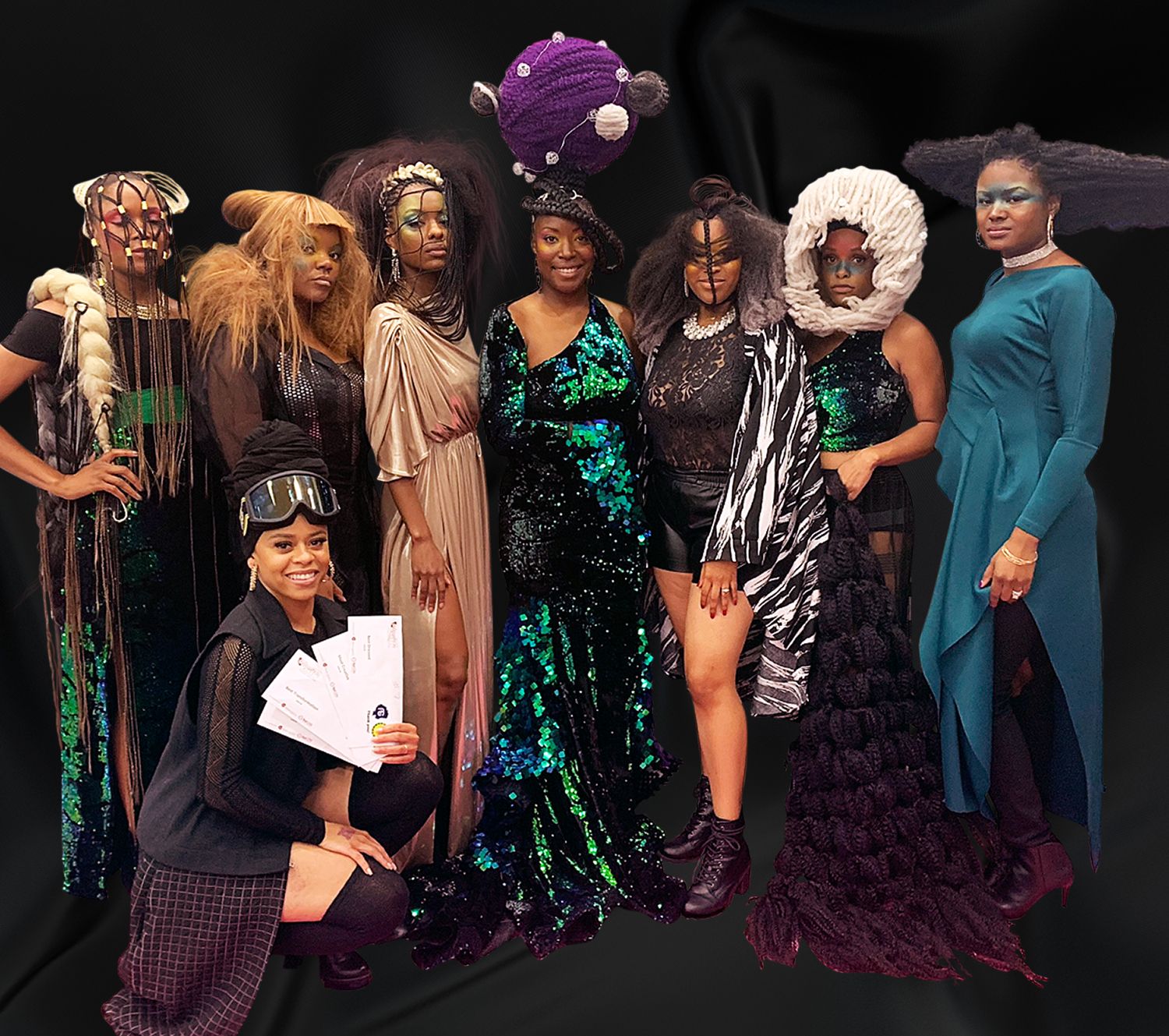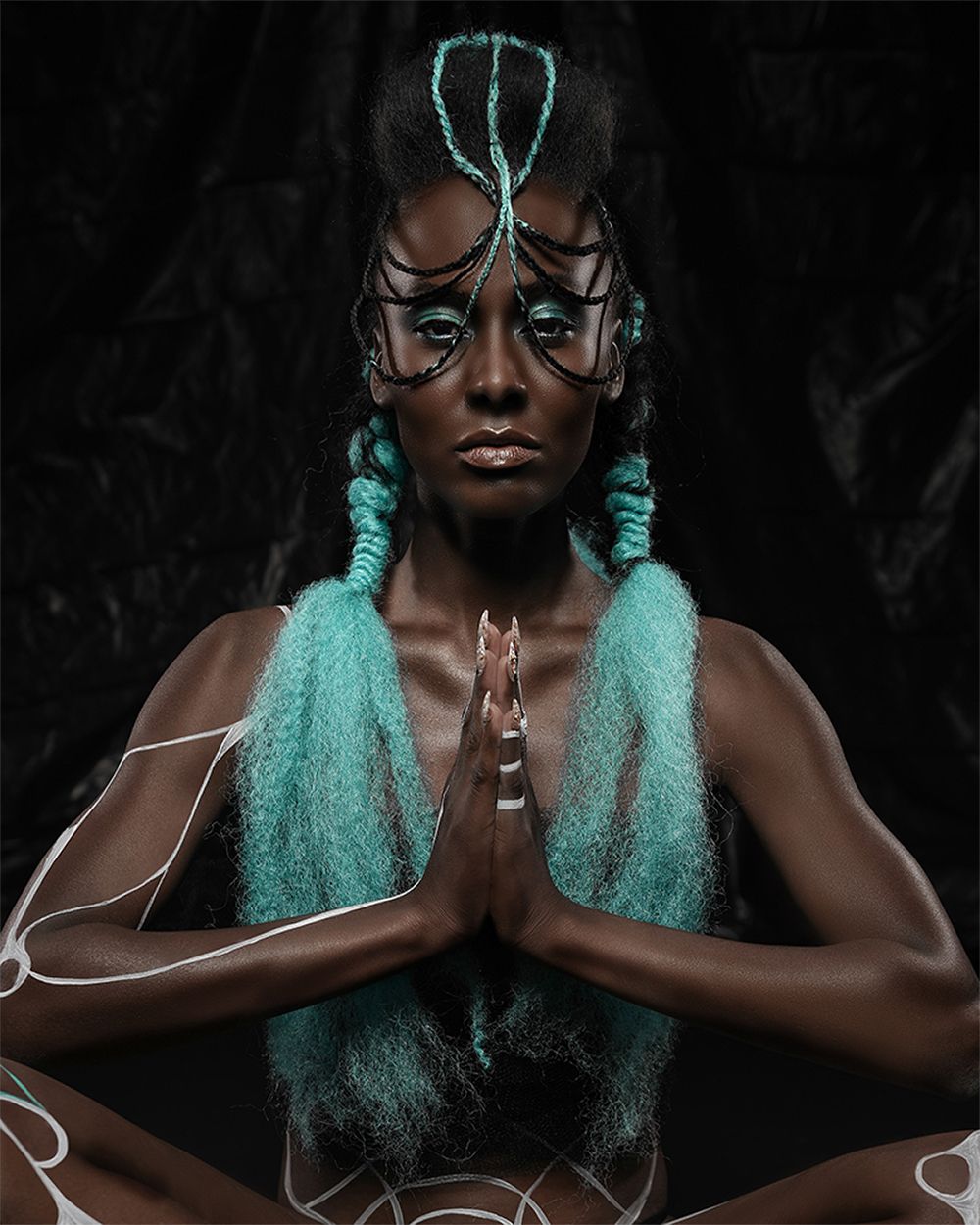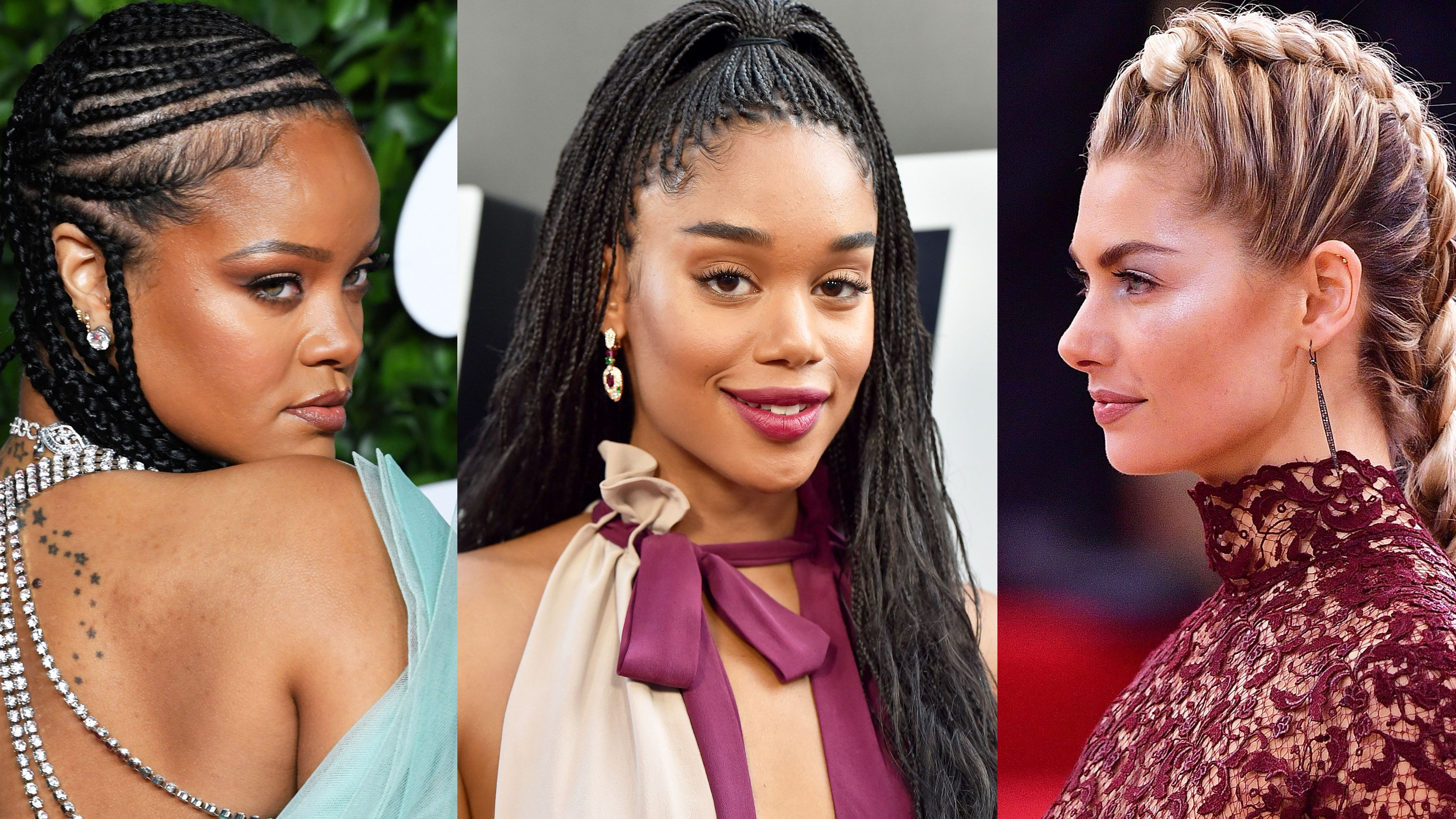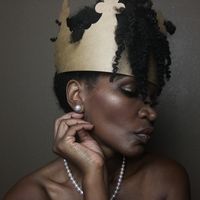Hair as Art
How styling Black hair became a cultural celebration.


Model Brittney King shows off Butterfly Braid by Grip and Twist.
It’s a buffet for the senses: dope music, grooving marching bands, flashing lights, and catsuit-clad hair models; hairstylists cutting neon strands in the dark and styling models’ hair upside down, underwater. The show-stopping pageantry and unparalleled floss of Black hair shows, including the Bronner Brothers International Beauty Show—the pinnacle of them all—are undeniable. Decades before the emergence of the Black Lives Matter movement and the introduction of the nation’s first CROWN Act (Creating a Respectful and Open World for Natural Hair), Black hair shows served as cultural incubators for creativity, community, commerce, and pride. They unapologetically showed the world that Black hair in its numerous reincarnations—whether braids, twists, or weaves—isn’t just beautiful. It’s art. It’s boundless. It’s political. Today these shows illustrate that if Black lives matter, then Black hair, and the laws that seek to protect it, must matter as well.
Black Hair Is an Event
More than 35,000 attendees pack the Georgia World Congress Center in Atlanta each February and August for the Bronner Brothers International Beauty Show, a hair competition that originated over 70 years ago to showcase the style and ingenuity of Black hairstylists and barbers. Attendees from around the globe network with industry leaders, learn from the 100-plus courses led by master stylists, and, of course, watch the legendary Bronner Brothers Hair Battle. “The battle attracts the best of the best in the world,” says James Bronner, senior VP of Trade Show Operations for Bronner Bros., Inc. (BB), the company his father Dr. Nathaniel H. Bronner Sr. and uncle Arthur E. Bronner Sr. started in 1947.
While BB initially focused on selling hair products, Nathaniel’s interactions with his customers revealed 1) that they were professionals who wanted to grow in their craft, and 2) that they were immensely creative. Nathaniel would snap pictures of the most extraordinary styles, publish them, and offer cash prizes for the top designs. Three-hundred people attended the first BB event, which “became a platform for people to launch their careers,” says James. From childhood, he watched his father and uncle (with the assistance of their sister Emma) empower and educate attendees, who enjoyed hearing from the business and civic leaders who spoke, including Dr. Martin Luther King Jr. and Dr. Benjamin Mays.
Today, six to eight contestants of the invite-only hair battle are allotted 15 minutes to wow the judges as they cut, transform, and style onstage. Contestants are judged on creativity, neatness, theme, and overall presentation. Contestants spare no expense, says James, who estimates that some spend an upwards of $10,000 creating their eye-popping masterpieces. The winner receives a championship belt resembling a heavyweight boxing belt, a $50,000 cash prize, and lifetime bragging rights. “It takes stylists to another level in their industry,” says James, noting that some champions go on to work for celebrities. For example, BB champion Terrence Davidson has since worked with Nicki Minaj, Patti Labelle, and Tyra Banks, among others.

Model Xandra Destin at the BB competition with hair styled by Merlande Petithomme
Master stylist Merlande Petithomme’s website proudly notes that she’s a four-time BB champion, which keeps her Georgia salon busy. The first-generation Haitian-American, who has competed in more than a dozen hair competitions, constantly pushes herself to outdo her last competitive feat. “When I do a hair battle, it’s like making a movie,” says Petithomme. Like any skilled Hollywood producer, she hires a writer and assistant; brainstorms themes; creates an overarching vision; and, finally, finds dancers, models, musicians, and makeup artists to bring the project to life.
Petithomme is known for her 2017 Caribbean Carnival–themed performance, during which she rode in on a camel and styled models’ hair in bright pinks, yellows, and greens. “It was real high fashion, runway hair, but sculptured, fantasy hair,” she says. Although she didn’t win, her entry (which took a nearly 200-person production team seven months to prepare) remains a standout, says James. Petithomme insists that standing out is paramount to winning. In Netflix’s We Are The Champions docuseries, an exploration of all sorts of unique competitions, she said “Some people win, but they don't get talked about. The show isn't memorable. Merlande will be memorable!”
Black Hair Is Art
Petithomme, who buys some of her materials at The Home Depot, describes herself as a “hair architect:” “I always relate hair to building a house. The foundation has to be stable. So whenever I create a fantasy look, I have to make sure that the piece fits and that it’s stabilized,” she explains.
Get exclusive access to fashion and beauty trends, hot-off-the-press celebrity news, and more.
Natural hair specialist Kelsie Lyn agrees that competitive hairstyling is a unique art form. “Anyone can do hair, but not everybody can do this kind or art,” she says. The Long Beach, California, celebrity stylist has amassed a fan base even though she has only competed in shows since 2016. “Kelsie is a favorite,” says Rwanda Ray, creator of the Afrolicious Natural Hair© & Beauty Expo. “Her stuff is so different, so out of the box,” Ray adds.

Stylist Kelsie Lyn (foreground) posing with her hair models at the Afrolicious Expo in 2019
Ray created the expo in 2013 to celebrate the natural kinks and coils of Black hair. What began as a 100-person gathering in Los Angeles burgeoned into a nationwide series with annual events in six different cities that draws thousands of naturals.
Ray added the Afrolicious Natural Hair and Braiding Competition to the expo in 2017 to showcase local stylists and wow attendees. Lyn didn’t sleep for two weeks before the 2019 Los Angeles competition because she wanted to perfect her looks, and Ray says that competitors commonly go through such extreme lengths to win because, “they don’t want to be outdone! They’re showmen and show women.”
“Avant-Garde” was the theme of that 2019 competition, and contestants were given boxes of colorful RastAfri hair to test their creativity. “I wanted to create otherworldliness in space,” says Lyn. After weeks of brainstorming, designing styles, and preparing looks for seven models, she made what she describes as “out-of-this-world elegance” for her seven-minute showcase. Her galactic looks garnered several awards, including “Most Creative” and the second-place overall prize. Lyn says she’s getting her feet wet in the competition world in order to eventually compete on a stage as big as BB.
Black Hair Is Boundless
The Afrolicous expo and BB hair battle both champion the beauty and versatility of braids and braiding techniques. In competition, braids can serve as the belle of the battle or the foundation for a spectacular sewn-in style.
A head-turning design at the February 2020 BB hair show was crafted by master braider Ashley Roberson, best known as “Grip and Twist” to her clients in Columbia, South Carolina. Roberson put forth a unique take on the butterfly braid, crafting a mohawk version. She braided the natural hair down the scalp in two large cornrows, smoothed the edges with gel, and then added the braided butterfly extension to the cornrows. Roberson attached two floor-length braids to the centered butterfly, added colorful smaller butterfly hairpins and white lights into the braids, and finished the model’s look with a gold cape that served as wings.
Roberson had turned heads previously. At the August 2019 BB show, she crafted a 10-foot-long braid in under 10 minutes. The model wrapped the design around her neck as a necklace and held it her hands like a purse. Giddy expo attendees jumped rope with it. Roberson always pushes her creativity against convention, telling students in her seminars: “Don’t be put into a box!”

Model LaToya Davis shows off hair by Merlande Petithomme
In the world of competitive hairstyling, out of the box is the norm. The bigger, the more eye-popping, the more jaw-dropping, the more likely a competitor is to walk away with the top prize. An up-and-coming competitor is Wakia-Sukari Gipson, a master braider based in Compton, California. Gipson snagged the first-place prize at the 2019 L.A. Afrolicious competition with a Men in Black–inspired entry, which, honestly, was too grandiose to describe here, although a moment worth mentioning is the two-headed alien that pompously paraded red, purple, and yellow chrysanthemums made of synthetic hair. In order to transform the hair into flowers, Gipson copied the technique used to make silk flowers. “I had to figure out a way for the hair to mimic ribbon,” she says, so she straightened and fused the hair with hairspray and a blow dryer, and then constructed the flowers with bobby pins.
Gipson uses the craft of hair braiding to inspire, educate, and give back to her community. She teaches braiding at the Roy W. Roberts II Watts/Willowbrook Boys & Girls Club in Los Angeles, where she spent her after-school hours as a teenager. Gipson notes that it’s important to teach her students the centuries-old history behind hair braiding. “I teach them that when we were in our homeland, braids signified your social status.” Royalty, for example, typically flaunted the most elaborate braided presentations.
Outside of Africa, on the lands where enslaved Africans were forced to live, braids sometimes symbolized liberty. “Women would braid clues to freedom routes in their hair,” Gipson shares. “This wasn’t just a hairstyle. It was life and death for us.”
Black Hair Is Political
Today, braided hairstyles represent cultural pride and personal expression—and they still symbolize freedom. Most states don’t give Black women and men the legal protection to wear braids at work and school. On July 3, 2019, California became the first state in the nation to pass the CROWN Act, which banned discrimination against natural hairstyles like braids, twists, and locs in public schools and workplaces. New York and five other states (New Jersey, Virginia, Colorado, Washington, and Maryland) quickly followed suit, along with a few cities. In September of last year, the U.S. House of Representatives passed the federal CROWN Act, which would have banned discrimination against natural hairstyles at the national level if approved by the Senate and signed into law. However, the Senate didn’t vote on the bill before Congress adjourned at the end of 2020. For the act to become federal law, it must be reintroduced and voted on by the current Congress. Supporters of the act insist that the road is long to see discriminatory hair laws and policies become relics of the past.

Models show of the many amazing designs showcased at Bronner Brothers competitions
“Very few of our federal representatives are going to step out on faith and know that they need to pass this until they see that people believe it,” says New York State Assemblywoman Tremaine S. Wright, who sponsored the New York CROWN legislation. The CROWN Coalition (a group led by the National Urban League, Color Of Change, Dove, and Western Center of Law & Poverty), launched a grassroots campaign to persuade state and federal lawmakers to pass the historic bill. “We have to build locally and keep pushing from state to state. That’s a part of the education process,” says Wright. To increase visibility around the legislation, which has failed to pass in 14 states, July 3 was designated National CROWN Day. Wright says that the push to pass the act at the state and federal levels won’t stop until lawmakers “understand that there’s a need and that us failing to act comes at a cost.”
Black women and men who’ve flexed their natural hair have paid dearly for it at times. Last year, Kienjanae Hooper, a senior at Gladewater High School in East Texas, was told that she’d have to remove her burgundy-tinted braids if she wanted to attend her graduation ceremony because the style violated the school’s dress code. Just as egregiously, in 2019, Andrew Johnson, a high school wrestler at Buena Regional High School in New Jersey, was ordered to cut off his locs or forfeit his wrestling match. These stories represent a plethora of cases in which students and workers are fighting for the right to wear their hair in race-based styles that reflect their culture.
While the current federal law enables workers to wear afros because that is how (some) black hair grows out of its follicles, other natural hairstyles like braids aren’t protected. Even though the Equal Employment Opportunity Commission (EEOC) now maintains that race can include characteristics associated with race, some courts argue that natural hairstyles are manipulations of black hair, and thus are not covered by the race protections guaranteed in the EEOC.
Some CROWN supporters wonder if it’s just good old-fashioned racism that impacts how the laws around natural hair are crafted and interpreted. Petithomme insists that the CROWN Act is critical: “Our hair is our identity. No one else is asked to change who they are.”

Wakia-Sukari Gipson modeling her own creation called For the Ancestors
Partnering with the coalition to gather signatures for the CROWN petition at the February 2020 show was a no-brainer for BB, a company that has affirmed the Black aesthetic and Black identity since its inception. James Bronner argues that companies that stifle employees’ hair choices unintentionally stifle the company’s success. “We’re very creative people,” he says, “If you limit [hair] creativity and box it in, you’re limiting the very thing you say you want from employees!”
Black Hair Is the Future
Regardless of what speed state and federal laws adapt to catch up with the culture, Black hair shows will continue to reign, wowing the world with their over-the-top, yet never-too-much levels of regalia. Although Ray had to rethink in-person Afrolicious expos due to the pandemic, (she cancelled the 2020 expos and will pivot to an outdoor version called the Afrolicious Marketplace highlighting Black businesses this year), her ultimate goal is unstymied: to become “the Essence Fest of hair.” BB’s virtual hair show, hosted from September 27 to 28, 2020, featured a virtual convention hall, educational classes, chat lounges for networking, and “The Best of the Hair Battles,” a compilation of standout hair battles from the last several years. Although BB had to transform a massive live event into an online one, plus pay extra to melanate the attendees’ online avatars and clothing, Bronner insists, “It was worth it”—15,000 people attended! BB believes that full adherence to COVID safety protocols for its planned August 2021 show in New Orleans is also worth it.
Absolutely worth it, because, like Petithomme says, “Black hair is life.”
This article has been updated to reflect the correct spelling of Rwanda Ray's name.
RELATED STORIES


Marie Claire: Bio: Chanté Griffin is a journalist based in Los Angeles. Her articles, essays, and interviews have appeared in The Washington Post, Ebony, The Los Angeles Times, and others. In her free time, she enjoys creating content for Kinky Coily Comedy, a platform that celebrates natural hair.
